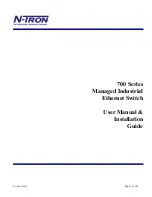
29-3
Catalyst 4500 Series Switch, Cisco IOS Software Configuration Guide - Cisco IOS XE 3.9.xE and IOS 15.2(5)Ex
Chapter 29 Configuring IPv6 Multicast Listener Discovery Snooping
About MLD Snooping
MLD Queries
The switch sends out MLD queries, constructs an IPv6 multicast address database, and generates MLD
group-specific and MLD group-and-source-specific queries in response to MLD Done messages. The
switch also supports report suppression, report proxying, Immediate-Leave functionality, and static IPv6
multicast MAC-address configuration.
When MLD snooping is disabled, all MLD queries are flooded in the ingress VLAN.
When MLD snooping is enabled, received MLD queries are flooded in the ingress VLAN, and a copy of
the query is sent to the CPU for processing. From the received query, MLD snooping builds the IPv6
multicast address database. It detects multicast router ports, maintains timers, sets report response time,
learns the querier IP source address for the VLAN, learns the querier port in the VLAN, and maintains
multicast-address aging.
When a group exists in the MLD snooping database, the switch responds to a group-specific query by
sending an MLDv1 report. When the group is unknown, the group-specific query is flooded to the
ingress VLAN.
When a host wants to leave a multicast group, it can send out an MLD Done message (equivalent to
IGMP Leave message). When the switch receives an MLDv1 Done message, if Immediate- Leave is not
enabled, the switch sends an MASQ to the port from which the message was received to determine if
other devices connected to the port should remain in the multicast group.
Multicast Client Aging
You can configure port membership removal from addresses based on the number of queries. A port is
removed from membership to an address only when there are no reports to the address on the port for
the configured number of queries. The default number is 2.
Multicast Router Discovery
MLD snooping performs multicast router discovery with these characteristics:
•
Ports configured by a user never age out.
•
Dynamic port learning results from MLDv1 snooping queries and IPv6 PIMv2 packets.
•
If multiple routers exist on the same Layer 2 interface, MLD snooping tracks a single multicast
router on the port (the router that most recently sent a router control packet).
•
Dynamic multicast router port aging is based on a default timer of 5 minutes; the multicast router is
deleted from the router port list if no control packet is received on the port for 5 minutes.
•
IPv6 multicast router discovery only takes place when MLD snooping is enabled on the switch.
•
Received IPv6 multicast router control packets are always flooded to the ingress VLAN, whether
MLD snooping is enabled on the switch.
•
After the discovery of the first IPv6 multicast router port, unknown IPv6 multicast data is forwarded
only to the discovered router ports (before that time, all IPv6 multicast data is flooded to the ingress
VLAN).
Summary of Contents for Catalyst 4500 Series
Page 2: ......
Page 4: ......
Page 2086: ...Index IN 46 Software Configuration Guide Release IOS XE 3 9 0E and IOS 15 2 5 E ...
















































